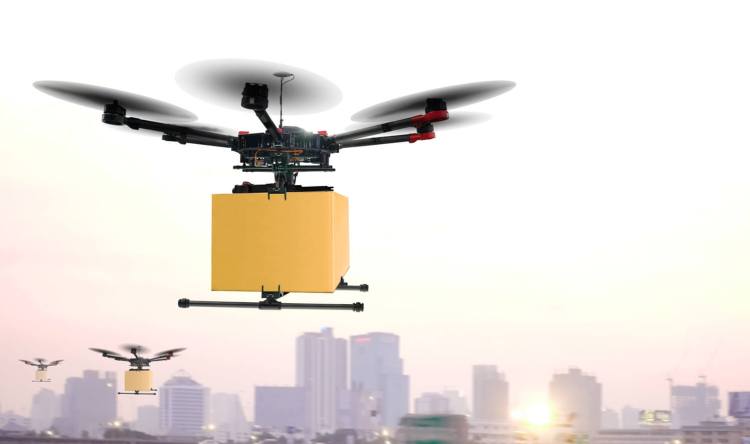2016 taught us a lot about drones and their potential to deliver benefits for consumers, communities, and businesses alike. Google and Chipotle tested burrito delivery on the campus of Virginia Tech, while cities nationwide turned to drones to help first responders, inspect bridges and roads, and monitor construction sites. We witnessed the launch of innovative products from Intel, Yuneec, DJI, Sensefly, and others — not to mention GoPro’s first drone. Through it all, we experienced changes in FAA regulations and the advent of Part 107, which has opened the skies for drone commerce, making once experimental drone operations completely routine.
And we’ve only scratched the surface. In 2017, we’re going to see drones come to the forefront of business, tech, and our daily lives. Let’s talk about what drones have in store for us next year.
Follow the money … away from venture capital
We’ll see VC investment in drones decline in 2017, but that doesn’t mean total investment will slow. Expect large enterprises like telecom companies and large consumer electronics brands to begin investing more seriously in the drone space — along with increased M&A activity and more strategic partnerships. More drone companies will prove they can generate revenue and will attract partners who can help them accelerate.
Big players will get into the game
Logistics companies like Amazon and DHL will start to put more and more drones in the air. Traditional retailers that have been developing drone strategies behind closed doors will announce their ideas for innovation and implementation, heating up the marketplace. Cloud players and corporate giants (think IBM or GE) will stake out expanded drone positions with long-term impacts for the entire industry. And Uber, after publishing its flying car white paper earlier this year, will convene its first “Elevate Summit” in 2017, bringing together a community of stakeholders that is looking to low-altitude airspace, not our roadways, for the future of mobility.
It’s a bird, it’s a plane, it’s 20,000 drones!
Today, we commonly see about 5,000 drones flying simultaneously around the world. With large consumer electronics, logistics, and telecom companies making major plays in the drone ecosystem, I predict that by the end of the year, that number will reach 20,000 simultaneous drone flights worldwide. That would represent a 400 percent increase next year.
Smart cities get even smarter
Many cities with “smart” inclinations are already considering what transportation and infrastructure will look like in 20, 50, and even 100 years — and are planning accordingly. These “smart government”-minded cities are investigating how unmanned aircraft could affect this future, and in 2017, we’ll see them make moves to establish themselves as top places for drones to do business. Next year, smart cities will invest in civic drone technology to be adopted by fire departments, police departments, and local administrators. And we might even see competition among the most connected cities as they try to attract the first drone deliveries to their communities.
Drones will be easier to buy and fly — and safer than ever
Prices for drones will continue coming down, even for drones with sophisticated features. The experience of flying a drone will become easier, especially as autonomous flight capabilities improve.
In 2017, the drone industry will build tools to help drones and their operators make accurate risk assessments, which can be used to identify safe flight plans, prevent accidents, and make drone flight even safer. In the U.S., we should see significant advancements on the road to Unmanned Traffic Management (the public-private partnership that will enable air traffic control and data exchange for millions of drones). Abroad, I expect we’ll see other countries open the skies for more automated flight beyond visual line of sight.
The bottom line: 2017 is the year of the drone
Whether we’re talking about who’s paying for them, who’s buying them, or how they are being used, drones will be pushed to the forefront of cultural, political, commercial, and consumer conversations in 2017. A shifting adoption landscape combined with new sources of funding and advanced improvements in technology should make 2017 a monumental year for the drone. I can’t wait to see what’s next.
Ben Marcus is cofounder and CEO of AirMap, an airspace management platform for UAS. He was previously cofounder and CEO of jetAVIVA and served as a flight test engineer for Eclipse Aviation. He is an FAA-certified Airline Transport Pilot and Flight Instructor with flight experience in more than 100 aircraft types and ratings in seaplanes, gliders, helicopters, and six types of jets. He is also a certificated Remote Pilot. He serves on the board of Angel Flight West, a non-profit organization that arranges free air transport in response to health care needs, and he flies volunteer missions for animal rescue groups Pilots N Paws and Wings of Rescue.
VentureBeat's mission is to be a digital town square for technical decision-makers to gain knowledge about transformative enterprise technology and transact. Learn More

